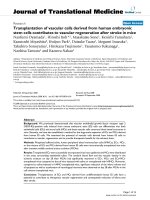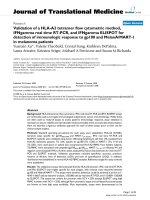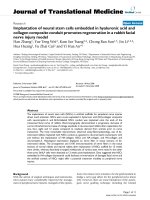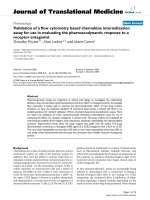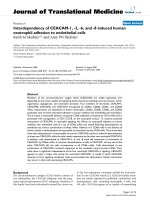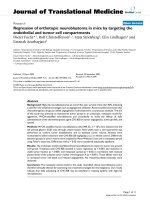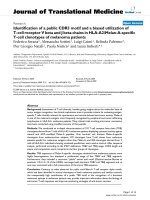báo cáo hóa học:" Revision of failed hip resurfacing to total hip arthroplasty rapidly relieves pain and improves function in the early post operative period" pdf
Bạn đang xem bản rút gọn của tài liệu. Xem và tải ngay bản đầy đủ của tài liệu tại đây (382.98 KB, 6 trang )
RESEARC H ARTIC LE Open Access
Revision of failed hip resurfacing to total hip
arthroplasty rapidly relieves pain and improves
function in the early post operative period
Nemandra A Sandiford
1*
, Sarah K Muirhead-Allwood
1,2
, John A Skinner
2
Abstract
We reviewed the results of 25 consecutive patients who underwent revision of a hip resurfacing prosthesis to a
total hip replacement. Revisions were performed for recurrent pain and effusion, infection and proximal femoral
fractures. Both components were revised in 20 cases.
There were 12 male and 13 female patients with average time to revision of 34.4 and 26.4 months respectively.
The mean follow up period was 12.7 months (3 to 31). All patients reported relief of pain and excellent satisfaction
scores. Two patients experienced stiffness up to three months post operatively.
Pre operative Oxford, Harris and WOMAC hip scores were 39.1, 36.4 and 52.2 respectively. Mean post operative
scores at last follow up were 17.4, 89.8 and 6.1 respectively (p < 0.001 for each score). These results show that con-
version of hip resurfacing to total hip arthroplasty has high satisfaction rates. These results compare favourably with
those for revision total hip arthroplasty.
Introduction
Metal on Metal (MoM) hip resurfacing has become
increasingly popular over the last decade. Data from the
United Kingdom (UK) National Joint Registry [1] suggest
that while hip resurfacing (HR) procedures account for
approximately 10% of all hip arthroplasty procedures in
the UK annually, the actual numb er of hip resurf acings
performed is steadily increasing from 2,338 in 2004 to
5,596 in 2007 [1]. The proposed benefits of HR compared
to total hip replacement include femoral bone preserva-
tion, increased stability, improved proprioception of the
hip joint and technically less demanding conversion to a
total hip replacement if necessary, particularly on the
femoral side. This is most relevant to young, active
patients.
While early results of Metal on Metal hip resurfacing
have been promising, complications have been reported
which require revision. These include femoral neck frac-
tures [2] and recurrent pain and effusions thought to be
related to a n aseptic lymphocytic vasculitis associated
lesion (ALVAL) syndrome [3]. Large destructive lesions
(pseudo tumors) have also been reported which lead to
soft tissue loss around the hip joint[4]. While it may be
relatively straightforward to revise a hip resurfacing to a
total hip replacement, the resu lts of this proced ure are
unknown. If there is a complication rate of a less invasive
procedure (hip resurfacing versus total hip replacement)
then one needs to know the functional outcome of the
revision procedure when considering it in young, active,
high demand patients.
This prospective study analyses the early functional out-
come of a cohort of patients who underwent conversion of
a hip resurfacing to a total hip replacement. We examine
the population undergoing revision and the indications for
revision. Parameters examined were the Oxford, Harris
and Western Ontario McMaster (WOMAC) hip scores,
relief of pain and patient satisfaction.
Patients and Methods
Twenty five consecutive patients underwen t revision of
resurfacing components to total hip arthroplasty in our
unit between 2006 and 2008. This cohort included 12
male and 13 female patients. Twenty patients had revision
of both components while the remaining five underwent
revision of the femoral component only. Pre and post
operative Oxford, Harris and WOMAC hip scores as well
* Correspondence:
1
The London Hip Unit, 4thFloor, 30 Devonshire Street, London, UK, W1G 6PU
Full list of author information is available at the end of the article
Sandiford et al. Journal of Orthopaedic Surgery and Research 2010, 5:88
/>© 2010 Sandiford et al; licensee BioMed Central Ltd. This is an Open Access article distributed under the terms of the Creative
Commons Attribution Li cense ( which permits unrestricted use , distribution, and
reproduction in any medium, provided the original work is properly cited.
as the University of California Los Angeles (UCLA) activ-
ity scores (Table 1) were collected. Other data including
gender, age, time to failure of the original implant and rea-
sons for failure were recorded (Table 2, 3). All hip scores
were collected prospectively.
All revision procedures were performed by a single
surgeon (SM-A) via a posterior approach using unce-
mented components. In all cases where infection was
suspected, capsular tissue as well as culture swabs of
both components and samples of any effusions were
sent for microbiological analysis. Stat istical analysis was
carried out using the unpaired student’ st-test(Graph
pad Prism software, California, USA)
Pre operative planning
Pre operative investigations included standard antero-
posterior and lateral x-rays of the pelvis and affected hip
respectively. Suspected ac etabular defects were further
investigated by computerized tomogra phy (CT) to con-
firm their 3-dimensional extent and actual size. These
were classified according to the American Association of
Orthopaedic Surgeons (AAOS) system [5].
Templating
Pre operative templating was performed as for primary
total hip replacement in all patients. (In those having
revision of the acetabulum and femora l components, a
ceramic on ceramic couple was used in 15 cases and
metal on ultra high molecular weight polyethylene in
four cases). W here both componen ts were revised, an
acetabular cup 2-4 mm larger than the in situ cup was
templated. In those patients in whom the acetabular
component was retained, a matching modular cobalt
chrome metal head was fixed to an uncemented stem.
Operative Technique
All procedures were performed via a posterior approach.
In cases where the acetabulum was preserved the femoral
neck osteotomy was performed and the head was
removed. Subsequent femoral preparation proceeded as
for a primary total hip replacement. A straight, tapered
reamer was inserted into the femoral canal followed by
incremental rasps as appropriate. Once the stem was
firmly seated, an appropriately sized large diameter cobalt
chrome head with a modular neck (Smith and Nephew,
Warwick, UK) was applied and reduction was performed.
In cases where both components were revised the
femoral neck osteotomy was performed after dislocation
of the joint. The in situ acetabular component was
removed using the Explant device (Zimmer, Warsaw,
Indiana) coupled to an adaptor device as previously
describe [6]. Acetabular defect s, if present, were packed
with a combination of morsellised auto and allograft.
Femoral revision proceeded as described above. All revi-
sion prostheses were uncemented. In cases of isolated
femoral revisions, Synergy (n = 4) and Echelon ( N = 1)
stems (Smith & Nephew, Warwick, UK) were inserted
to which a large diameter cobalt chrome head was
applied. Where both components were revised, the
metal on metal bearing was replaced by ceramic on
ceramic components. A posterior capsular repair was
performed in all cases. Sutures were placed into the cap-
sule using the Mason-Allen technique [7] and attached
to the posterior edge of the greater trochanter via drill
holes.
Table 1 Modified University of California Los Angeles (UCLA) activity scale
Category Activity level
1 Inactive: Wholly inactive. Dependent on others. Cannot leave residence
2 Mostly inactive: Restricted to minimum activities of daily living.
3 Mild activity: Sometimes participates in mild activities such as walking, limited housework and shopping.
4 Regularly participates in mild activities. Sedentary occupational work.
5 Moderate activity: Sometimes in moderate activities such as swimming and can do unlimited housework or shopping.
6 Regularly participates in moderate activities. Light occupational work
7 Active Regularly participates in active events such as bicycling, aqua-aerobics. Gardening or working out in the gym once or twice a week.
8 Very active: Regularly participates in very active events such as bowling, golf. Riding, hunting, aerobics. Gardening or working out in the
gym three times per week or more. Moderately heavy occupational work. Farming.
9 Impact sports: Sometimes participates in impact sports such as running, jogging, tennis, cricket, baseball, rugby, football, hockey, racquet
sports, judo, karate and other martial arts, skiing, acrobatics, ballet dancing, backpacking and mountaineering.
Heavy occupational work.
10 Regularly participates in impact sports as described above
Table 2 Patient Demographics
Males Females
Number of patients 13 12
Mean Age/years 62.2 (56-72) 58.5 (41 - 65)
Time to revision (months) 34.4 (4-65) 26.4 (7-60)
Infections 1 1
Femoral neck fractures (due to falls) 2 0
Femoral component size 49 (46-54) 43 (38-50)
Retained acetabular components 4 1
Sandiford et al. Journal of Orthopaedic Surgery and Research 2010, 5:88
/>Page 2 of 6
Post Operative Care
A drain was l eft deep to the fascia lata for 24 hours in all
cases. All patients received 3 doses of prophylactic antio-
biotics. Low molecular weight heparin, thromboembolic
deterrent (TED) stockings and calf compression devices
were used to decrease the risk of thromboembolic events.
Patients who required bone g raft for th e acetabul um
were mobilized partial weight bearing f or the first four
weeks while those not requiring gr aft were allowed to
fully weight bear from day 1 post-operatively. Average
duration of stay was 5 days (Range 4-7 days).
A cour se of physiotherapy was started 4-6 weeks post
operatively i n order to improve s trength and flexibility
of the abductors and hip flexors and facilitate gait
retraining. Full activity was permitted from 3 months.
Follow Up
Patients were routinely followed up at 4 weeks, 12
weeks, one year post operatively and at 3 yearly intervals
afterward. Clinical and radiological evaluation were per-
formed at each follow up visit. Stable fixation of both
components was indicated by lack of ra diolucent lines
and lytic lesions and the presence of spot welds at the
bone prosthesis interface as well as trabeculae extending
to the uncemented stem [8] (Figure 1). Oxford, Harris
and WOMAC hip scores were also recorded.
Results
Twenty five patients were included in this study. There
were 12 females and 13 males. The mean ages of the male
and female cohorts were 62.2 (range 56-72 years) and 58.5
years (range 41 - 65 years) respectively. One patient was
lost to follow up as she currently resides overseas but at
3 months she had returned to full function and had no
pain. The average duration of follow up was 12.7 months
(3-31). Eight patien ts were followed for a minimum of 24
months. The demographics of our patient cohort are illu-
strated in Table 2.
Indications for revision included pain localized to the
groin (24%), pain not resolving after extended bouts of
sport activity (8%), pain with clicking (8%), pain with an
effusion (40%), dislocation (4%), femoral neck fracture
secondary to a fall (8%) and infection (8%) (Table 3).
The average time to revision was 30.2 months (4 - 65
months) overall. Among female patients it was 26.4
months (7 - 60) and 34.4 months (4-65) in the male group
(p = 0.27). The average femoral component size in the
female group was 43 (38-50) compared to 49 (46-54) in
the male patients (p = 0.0003, CI 3.27-8.93).
In cases where both components were revised, the aver-
age size of the expl anted acetabular co mponent was 50.7
mm (46 - 58 mm) compared to 54.6 mm (52 - 60) post
revision. Intra operative findings were varied based on the
diagnosis. All patients except those with femoral neck
fractures had at least a small effusion. Three patients had
black staining of the pseudo capsule and periarticular soft
tissues suggesting deposition of metallic debris.
Effusions were charcoal coloured in 3 cases and cream
coloured in one patient in the absence of infection.
Cystic lesions were noted behind the acetabular compo-
nent in 3 cases but the cup was grossly loose in only
oneofthese.Therewasevidenceofgrosscollapseofa
segment of the femoral head (evidenced by softening of
the bone at the margin of the prosthesis) in one patient.
Pre operative Oxford, Harris and WOMAC hip scores
were 39.1, 36.4 and 52.2 respectively. Post operative
scores were 17.4, 89.8 and 6.1 respectively p < 0.0001,
p < 0.0001 and p < 0.0001 respectively (Figu re 2). The
greatest i mprovement was seen in the pain component
of the Harris Hip Score with an average improvement of
35 units (79.5%) at the time of last follow up.
The average UCLA activity score increased from 3 to
8. Two patients had returned to extreme sports (though
this was against our advice).
There were no cases of symptomat ic leg length discre-
pancy, new infection or neurological complications post
operatively. All patients except those with acetabular bone
graft were allowed to fully weight bear day 1 post opera-
tively. The average post operative length of stay was
5 days. All patients were satisfied with their outcome at
their last follow up. Two patients were unable to access
their shoelaces at 3 months post opera tively. One patient
had these complaints pre operatively while the other
patient recovered his normal hip flexion after a prolonged
A
B
Figure 1 A- Preoperative X-ray study showing gross loosening
of the socket with a femoral neck fracture; B- Post operative
X-ray six months later.
Table 3 Indications for revision
Diagnosis Number of patients
Infection 2
Groin pain 6
Unexplained pain after sport 2
Pain with clicking 2
Pain with effusion 10
Dislocation 1
Femoral neck fracture secondary to fall 2
Sandiford et al. Journal of Orthopaedic Surgery and Research 2010, 5:88
/>Page 3 of 6
course of physiotherapy. All patients have reported resolu-
tion of their pain post revision.
Discussion
Metal on metal resurfacing arthroplasty has seen a rise
in popularity over the last decade. Early results of con-
temporary resurfacing have shown success rates a bove
97.8% at a mean of 5 years in the young, active popula-
tion [9]. Despite these good early results complications
have been noted inc luding femoral neck f ractures [2]
and (at present) ill defined hypersensitivity/i mmune
reactions associated with the metal on metal bearings
(Figures 1, 3, 4, 5). The aetiology o f these reactions
remains under investigation but is not fully character-
ized [3,10]. As a result we have chosen to adopt a
descriptive classification of our findings unti l the spec -
trum of this pathology is fully known. Similarities have
been found to the cohort described by W illert et al [3]
including the early recurrence of pain similar to pre
operativelevelsandthepresenceofaneffusionorsoft
tissue swelling. Histological studies have revealed peri-
vascular T and B lymphoctyte aggregation in the major-
ity of these cases. All patie nts with this pre sentation
were revised to ceramic on ceramic bearing couples.
While it is not fully understood it would seem logical to
avoid cobalt chrome components in the bearing couple
when revising for this indication.
While it is too early to comment on the clinical out-
comes of these prostheses, the main determinants of
success in these patients are pain relief and return to
their normal physical function. One of the main pro-
posed benefits of hip resurfacing arthroplasty i s an
improved range of movement and stability of the large
diameter bearing. These should theoretically confer
increased range of movement theoretically allowing a
higher level of function. Prior to having their primary
procedures these patients were all involved in sporting
activities (ranging from tennis to snowboarding) which
were discontinued due to pain after their surgery. Up to
the last follow up all patients had returned to their nor-
mal jobs, activities of daily living and sports. This corre-
sponded to elimination of their pain and increased
UCLA activity scores.
0
10
20
30
40
50
60
70
80
90
Oxford
Harris
WOMAC
Pre op
Post op
A
B
Figure 2 Pre and post operative hip scores.
A
Figure 3 Varus positioning of th e femoral component.This
patient presented with progressive pain and inability to return to
normal activity.
A
B
Figure 4 Loosening of the femoral component (arrow shows
the reactive lines around the loose stem).
A
B
Figure 5 A comminuted complex intertrochanteric fracture
occurring due to the patient falling from his bicycle. The
acetabular component was retained in this case.
Sandiford et al. Journal of Orthopaedic Surgery and Research 2010, 5:88
/>Page 4 of 6
It has be en stated that revision of a hip r esurfacing to
a total hip replacement is a relatively simple procedure.
While there is no doubt that hip resurfacing conserves
bone on the femoral side, it has been suggested that it
removes more acetabular bone [11]. While preparation
of the femoral component is similar to conventional hip
arthroplasty, revision of the acetabular component can
be a technically demanding procedure with the risk of
acetabular bone loss. In this series only 1 of 20 cups
was loose. The remainder had to be extracted from sur-
rounding bone
There were no episodes of clinical deep vein throm-
boses (DVT’s), leg length discrepancy or infection up to
the time of last follow up. These early results compare
favourably with similar reports for total hip replace-
ments in young patients [12] and revision hip arthro-
plasty [13].
All patients were satisfied particularly by their pain
relief. Average post operative Oxford, Harris and
WOMAC hip scores were 17.4, 89.8 and 6.1 respec-
tively. representing statistical ly significant improvements
over pre operative scores (p < 0.0001 for each score).
The group who had infected prostheses improved more
slowly than their non infected counterparts but reported
equal rates of satisfaction.
Two patients (1 female, 1 male) had infected prostheses
requiring revision. Both patients presented with pain and
effusions but no systemic symptoms. The infecting
organisms were Staphylococcus Aureus Staphylococcus
Epidermididis. These patients had normal looking
wounds with no redness sinuses or discharge. Their ery-
throcyte sedimentation rates (ESR) were 48 and 27 and
C- Reactive pro tein (CRP) lev els were 96 and 56. Their
White blood cell counts (WBC’ s) were less than 11 in
both cases. No pus was discovered intraoperatively in
these patients. They were both treated with one satge
revisions and treated with six week courses of suitable
antibiotics. The infection settled in both cases.
Gender
The ratio of male to female patients in our cohort is 1:1.
The average age o f females is 58.7 years (41 - 61)) and
for males 61.5 years (51 - 72) reflecting higher failure
rates in a younger female population. The rea sons for
revision based on gend er are presented i n Table 2. Four
males (and no females) presented with symptoms relat-
ing to activity potentially reflecting increased activit y in
this group after hip resurfacing. Conversely the female
cohort all pr esented with pain and effu sions which were
successfully treated by revision of the bearing couples.
Osteolytic lesions behind the acetabular components
were only noted in female patients. T his is an interest-
ing observation that is difficult to explain. It may be
that it is a chance finding, though it may also suggest
that hypersensitivity t ype reactions t o metal on metal
articulations are more common in females. Our cohort
suggests show that female patients with smaller dia-
meter bearing surfaces have higher failure rates. This
has recently been reported in recently presented data
from a series of over 1000 patients (Treacy, personal
communication). The average sizes of femoral compo-
nents b ased on gender is shown in Figure 6. It m ay be
that the female gender is a surrogate marker for small
component size and it may be that problems are more
common with smaller size metal on metal bearings.
Excluding the patients with infection, hip scores were
sim ilar in male and female patients. Unexplained painful
reactions often with an effusion seems to be a real phe-
nomenon with a small proportion of metal on metal
articulations. These symptoms can be so severe that revi-
sion is indicated. They seem to be more common in
females. Revising them to a total hip replacement with
non metal on metal bearings produces rapid early pain
relief. This is associated with good objective outcome
measures. Infection after hip resurfacing can be eradi-
cated. Recovery, as with infection after total hip replace-
ment is slower and ultimate hip scores are lower [14].
Conclusion
Our paper shows that the short term outcome of revision
of hip resurfacing to total hip replacement gives high
patient satisfaction, good function and pain relief. Unex-
plained pain reactions seem to be more common in female
patients with smaller dia meter components while those
who are revised due to infection progress more slowly.
Techniques for maximal acetabular bone preservation
have been described, particularly for the BHR component
while conversion of a resurfacing femoral component is as
bone conserving as a primary femoral stem [6].
While the complication rates in this group are encoura-
ging compared to both primary and revision total hip
replacement, caution should be used in drawing conclu-
sions from this as the follow up period is relatively short
30
35
40
45
50
55
60
05
1
0
1
5
Males
Females
Figure 6 Acetabular sizes based on gender.
Sandiford et al. Journal of Orthopaedic Surgery and Research 2010, 5:88
/>Page 5 of 6
and longer term results are necessa ry. It is also logical to
assume that as the number of re surfacings i ncrease, so
will the number of revisions. This will provide larger ser-
iesforstudyandalsoprovidedatabasedoncomponent
design.
Informed Consent
Informed consent was obtained from each patient partici-
pating in this study. Permission was obtained for publish-
ing the images used in this paper. A copy of this would be
available for review by the Editor- in- Chief of this journal
Author details
1
The London Hip Unit, 4thFloor, 30 Devonshire Street, London, UK, W1G
6PU.
2
The Royal National Orthopaedic Hospital, Stanmore, Middlesex, UK,
HA7 4LP.
Authors’ contributions
NS Reviewed the patients clinically, collected the data, organized and
prepared the first draft of the paper. SMA identified the topic as a subject of
current interest, reviewed the patients clinically and edited the written paper
while JAS reviewed the radiographs, co-authored the discussion and results.
All authors have approved the final manuscript.
Competing interests
The authors declare that they have no competing interests.
Received: 10 May 2010 Accepted: 29 November 2010
Published: 29 November 2010
References
1. National Joint Registry: [ />aspx?fileticket=QkPI7kk6B2E%3d&tabid = 86&mid = 523].
2. Shimmin AJ, Bare J, Back DL: Complications associated with hip
resurfacing arthroplasty. Orthop Clin North Am 2005, 36(2):187-93.
3. Willert HG, Buchhorn GH, Fayyazi A, Flury R, Windler M, Köster G,
Lohmann CH: Metal-on-metal bearings and hypersensitivity in patients
with artificial hip joints. A clinical and histomorphological study. J Bone
Joint Surg Am 2005, 87(1):28-36.
4. Glyn-Jones S, Pandit H, Kwon YM, Doll H, Gill HS, Murray DW: Risk factors
for inflammatory pseudotumour formation following hip resurfacing.
J Bone Joint Surg Br 2009, 91(12):1566-74.
5. D’Antonio JA, Capello WN, Borden LS, Bargar WL, Bierbaum BF,
Boettcher WG, Steinberg ME, Stulberg SD, Wedge JH: Classification and
management of acetabular abnormalities in total hip arthroplasty. Clin
Orthop Relat Res 1989, , 243: 126-37.
6. Kragh JF Jr, Svoboda SJ, Wenke JC, Ward JA, Walters TJ: Suturing of
lacerations of skeletal muscle. J Bone Joint Surg Br 2005, 87(9):1303-5.
7. Sandiford NA, Kabir C, Muirhead-Allwood SK, Skinner J, Nuthall T: Revision
of the Birmingham Hip Resurfacing cup: technical notes and the use of
a novel technique to overcome unique problems. Hip Int 2008,
18(3):220-3.
8. Engh CA, Massin P, Suthers KE: Roentgenographic assessment of the
biologic fixation of porous-surfaced femoral components. Clin Orthop
Relat Res 1990, , 257: 107-28, Erratum in: Clin Orthop 1992 Nov;(284):310-2.
9. Hing CB, Back DL, Bailey M, Young DA, Dalziel RE, Shimmin AJ: The results
of primary Birmingham hip resurfacings at a mean of five years. An
independent prospective review of the first 230 hips. J Bone Joint Surg Br
2007, 89(11):1431-8.
10. Davies AP, Willert HG, Campbell PA, Learmonth ID, Case CP: An unusual
lymphocytic perivascular infiltration in tissues around contemporary
metal-on-metal joint replacements. J Bone Joint Surg Am 2005,
87(1):18-27.
11. Loughead JM, Starks I, Chesney D, Matthews JN, McCaskie AW, Holland JP:
Removal of acetabular bone in resurfacing arthroplasty of the hip: a
comparison with hybrid total hip arthroplasty. J Bone Joint Surg Br 2006,
88(1):31-4.
12. Dorr LD, Takei GK, Conaty JP: Total hip arthroplasties in patients less than
forty-five years old. J Bone Joint Surg Am 1983, 65(4):474-9.
13. Goodman SB, Oh KJ, Imrie S, Hwang K, Shegog M: Revision total hip
arthroplasty in juvenile chronic arthritis: 17 revisions in 11 patients
followed for 4-12 years. Acta Orthop 2006, 77(2):242-50.
14. Scharfenberger A, Clark M, Lavoie G, O’Connor G, Masson E, Beaupre LA:
Treatment of an infected total hip replacement with the PROSTALAC
system. Part 2: Health-related quality of life and function with the
PROSTALAC implant in situ. Can J Surg 2007, 50(1)
:29-33.
doi:10.1186/1749-799X-5-88
Cite this article as: Sandiford et al.: Revision of failed hip resurfacing to
total hip arthroplasty rapidly relieves pain and improves function in the
early post operative period. Journal of Orthopaedic Surgery and Research
2010 5:88.
Submit your next manuscript to BioMed Central
and take full advantage of:
• Convenient online submission
• Thorough peer review
• No space constraints or color figure charges
• Immediate publication on acceptance
• Inclusion in PubMed, CAS, Scopus and Google Scholar
• Research which is freely available for redistribution
Submit your manuscript at
www.biomedcentral.com/submit
Sandiford et al. Journal of Orthopaedic Surgery and Research 2010, 5:88
/>Page 6 of 6
